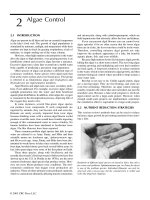Business and society ethics sustainability and stakeholder management 9e chapter 2
Bạn đang xem bản rút gọn của tài liệu. Xem và tải ngay bản đầy đủ của tài liệu tại đây (1.99 MB, 40 trang )
© 2015 Cengage Learning
1
Chapter 2
Corporate
Citizenship: Social
Responsibility,
Responsiveness,
and Performance
© 2015 Cengage Learning
2
Learning Outcomes (1 of 2)
1. Explain how corporate social responsibility (CSR)
evolved and encompasses economic, legal, ethical, and
philanthropic components.
2. Provide business examples of CSR and corporate
citizenship.
3. Differentiate between corporate citizenship, social
responsibility, responsiveness, and performance, and
sustainability.
4. Elaborate on the concept of corporate social
performance (CSP).
© 2015 Cengage Learning
3
Learning Outcomes (2 of 2)
5. Explain how corporate citizenship develops in stages in
companies.
6. Describe the triple bottom line and its relevance to
sustainability.
7. Describe the socially responsible investing movement’s
characteristics.
© 2015 Cengage Learning
4
Chapter Outline
•
•
•
•
•
•
•
•
•
The Corporate Social Responsibility (CSR) as a Concept
Traditional Arguments Against and For CSR
Corporate Social Responsiveness
Corporate Social Performance
Corporate Citizenship
Social Performance and Financial Performance Relationship
Sustainability – Profits, People, Planet
Socially Responsible, Sustainable, Ethical Investing
Summary
© 2015 Cengage Learning
5
Allegations Against Business Business • Has little concern for the consumer
• Cares nothing about the deteriorating
social order
• Has no concept of ethical behavior
• Is indifferent to the problems of
minorities and the environment
• These claims have generated an
unprecedented number of pleas for
companies to be more socially
responsible.
© 2015 Cengage Learning
6
Corporate Social Responsibility
As a Concept
Early Definitions -
•CSR means seriously considering the impact
of a company’s actions on society.
•CSR requires the individual to consider his
or her acts in terms of a whole social system,
and holds him or her responsible for the
effects of his or her acts anywhere in that
system.
•These definitions provide useful insights
into the concept of Corporate Social
Responsibility.
© 2015 Cengage Learning
7
Business CriticismSocial Responsibility Cycle
Factors in the Societal Environment
Criticism of Business
Increased Concern
for the Social Environment
A Changed
Social Contract
Business Assumption of
Corporate Social Responsibility
Social Responsiveness, Social
Performance, and Corporate Citizenship
A More Satisfied Society
Fewer Factors Leading to
Business Criticism
Increased Expectations
Leading to More Criticism
© 2015 Cengage Learning
8
Corporate Citizenship Concepts
© 2015 Cengage Learning
9
Historical Perspective on CSR
Economic Model
Legal Model
Social Model
Stakeholder Model
© 2015 Cengage Learning
10
Modifications of the Economic Model
Philanthropy
Philanthropy
Community
Communityobligations
obligations
Paternalism
Paternalism
Motivation:
Motivation:
Keep
Keepgovernment
governmentat
atarm’s
arm’slength
length
© 2015 Cengage Learning
11
Evolving Meanings of CSR
•
CSR:
•
…is seriously considering the impact of
the company’s actions on society.
•
… is the obligation of decision makers to
take actions that protect and improve the
welfare of society as a whole, along with
their own interests.
•
…supposes that the corporation has
economic and legal obligations as well as
responsibilities to society that extend
beyond these obligations.
© 2015 Cengage Learning
12
A Four-Part Definition of CSR
While each definition is valuable, we will
focus on the types of social responsibilities
business has. Corporate social responsibility
encompasses the:
Economic
Legal
Ethical, and
Discretionary
expectations that society has of organizations
at a given point in time.
© 2015 Cengage Learning
13
The Four Components of CSR
Responsibility
Societal
Expectation
Examples
Economic
Required
Be profitable. Maximize sales,
minimize costs.
Legal
Required
Obey laws, adhere to
regulations
Ethical
Expected
Avoid questionable practices.
Do what is right, fair, and just
Philanthropic
Desired/
Expected
Be a good corporate citizen.
Give back.
© 2015 Cengage Learning
14
The Pyramid of CSR
Philanthropic
PhilanthropicResponsibilities
Responsibilities
Be
Beaagood
goodcorporate
corporatecitizen.
citizen.
Ethical
EthicalResponsibilities
Responsibilities
Be
Beethical.
ethical.
Legal
LegalResponsibilities
Responsibilities
Obey
Obeythe
thelaw.
law.
Economic
EconomicResponsibilities
Responsibilities
Be
Beprofitable.
profitable.
© 2015 Cengage Learning
15
The CSR Equation
Economic Responsibilities
+
Legal Responsibilities
+
=
Ethical Responsibilities
Total
Corporate
CSR
+
Philanthropic Responsibilities
A stakeholder perspective focuses on the CSR
pyramid as a unified whole.
© 2015 Cengage Learning
16
Top 20 Activities or Characteristics of
Socially Responsible Companies
•
•
•
•
•
•
•
•
•
•
•
Makes products that are safe.
Does not pollute air or water.
Obeys the law in all aspects of
business.
Promotes honest or ethical employee
behavior.
Commits to safe workplace ethics.
Does not use misleading or deceptive
advertising.
Upholds stated policy banning
discrimination.
Utilizes “environmentally friendly”
packaging.
Protects employees against sexual
harassment.
Recycles within company.
Shows no past record of
questionable activity.
•
•
•
•
•
•
•
•
•
Responds quickly to customer
problems.
Maintains waste reduction program.
Provides or pays portion of medical
costs.
Promotes energy conservation
program.
Helps displaced workers with
placement.
Gives money toward charitable or
educational causes.
Utilizes only biodegradable or
recyclable materials.
Employs friendly or courteous or
responsive personnel
Tries continually to improve quality.
© 2015 Cengage Learning
17
Arguments Against CSR • Classical Economics: The classical economic
view is that business’ only goal is the
maximize profits for owners.
• Business Not Equipped: Business is not
equipped to handle social activities.
• Dilutes Business Purpose: It dilutes the
primary purpose of business.
• Too Much Power Already: Businesses have
too much power already .
• Global Competitiveness: It limits the ability
to compete in a global marketplace.
© 2015 Cengage Learning
18
Arguments For CSR • Enlightened self-interest: Businesses must
take actions to ensure long-term viability.
• Warding off government regulations. This
is one of the most practical reasons.
• Resources Available: Business has the
resources and expertise. Let it try.
• Proaction is better than Reaction.
Proaction is also less costly.
• Public supports: the public strongly
supports CSR.
© 2015 Cengage Learning
19
Business Responses to calls for CSR Make
the Business Case for CSR
Defensive approach
Cost-benefit approach
Strategic approach
Innovation and learning approach
© 2015 Cengage Learning
20
The Business Case for CSR
6 Reasons for Embracing CSR
4. Attract, retain, and maintain a
happy workforce and be an
1.Innovation
Employer of Choice.
2.Cost savings
5. Save money on energy and
3.Brand differentiation
operating costs and manage risk.
4.Long-term thinking
6. Differentiate itself from
5.Customer engagement
competitors
6.Employee engagement
7. Improve its business reputation
and standing
Business Benefits of CSR
8. Provide access to investment and
1.Win new business
funding opportunities
2.Increase customer retention
9. Generate positive publicity and
3.Develop and enhance relationships
media opportunities due to
with customers, suppliers, and
media interest in ethical business
networks.
activities.
© 2015 Cengage Learning
21
Corporate Social Responsiveness
Corporate Social Responsiveness •An action-oriented variant of CSR.
Responsibility •Implies a state or condition of having
assumed an obligation.
Responsiveness •Connotes a dynamic, action-oriented
condition.
© 2015 Cengage Learning
22
Corporate Social Responsiveness
Other Views •Sethi’s Three-Stage Schema
•
Social obligation, social responsibility, and
social responsiveness; anticipatory,
preventive
•Frederick’s CSR1, CSR2, and CSR3
•
CSR1 is accountability-focused.
•
CSR2 is responsibility-focused.
•
CSR3 refers to corporate social rectitude.
•Epstein’s Process View
•
Emphasizes the process of social
responsiveness.
© 2015 Cengage Learning
23
Corporate Social Performance:
Carroll’s Model
© 2015 Cengage Learning
24
Corporate Social Performance:
Wartick & Cochran’s Model Extensions
© 2015 Cengage Learning
25









